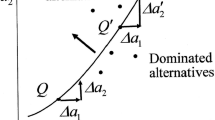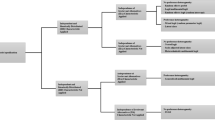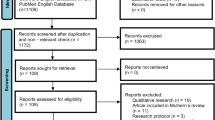Abstract
Scope insensitivity and embedding are fundamental concerns in contingent valuation studies for health risk reductions. Recently, choice experiments have increasingly been used to obtain contingent willingness to pay (WTP) estimates. We juxtapose the WTP estimates of a choice experiment (CE) to those of the contingent valuation method (CVM) for different health risk reductions and compare them in the extent of scope insensitivity and embedding. WTP using CVM is scope sensitive for single health risks, but embedding is observed for multiple disease risks. In contrast, WTP based on the CE is highly scope sensitive and convex in risk reduction levels.




Similar content being viewed by others
Notes
The equality of WTP estimated by CVM and CE were compared using the convolutions approach. By using the complete combinatorial of the two WTP distributions (Poe et al. 2005) obtained in nonparametric bootstraps of N = 500, the lower bound of the 90% confidence interval of the difference is given by: 0.392 (CVMSa40, Ca0 = CESa40, Ca0), 3.803 (CVMSa80, Ca0 = CESa80, Ca0), 0.990 (CVMSa0, Ca40 = CESa0, Ca40), 0.601 (CVMSa0,Ca80 = CESa0, Ca80), −0.511 (CVMSa40, Ca40 = CESa40, Ca40), 0.848 (CVMSa80, Ca40 = CESa80, Ca40), 0.301 (CVMSa40, Ca80 = CESa40, Ca80), and 3.065 (CVMSa80, Ca80 = CESa80, Ca80). Zero is included in the confidence interval only for the case CVMSa40, Ca40 = CESa40, Ca40 where equality of the WTP distributions can hence not be rejected.
References
Adamowicz, Wiktor, Peter Boxall, Michael Williams, and Jordan Louviere. (1998). “Stated Preferences Approaches for Measuring Passive Use Values: Choice Experiments and Contingent Valuation,” American Journal of Agricultural Economics 80(1), 64–75.
Alberini, Anna. (1995). “Optimal Designs for Discrete Choice Contingent Valuation Surveys: Single-Bounded, Double-Bounded, and Bivariate Models,” Journal of Environmental Economics and Management 28(3), 287–306.
Alfnes, Frode. (2004). “Stated Preferences for Imported and Hormone-treated Beef: Application of a Mixed Logit Model,” European Review of Agricultural Economics 31(1), 19–37.
Ariely, Dan, George Loewenstein, and Drazen Prelec. (2003). “‘Coherent Arbitrariness’: Stable Demand Curves Without Stable Preferences,” Quarterly Journal of Economics 118(1), 73–105.
Bateman, Ian, Alistair Munro, Bruce Rhodes, Chris Starmer, and Robert Sugden. (1997). “Does Part-whole Bias Exist? An Experimental Investigation,” Economic Journal 107, 322–332.
Carson, Richard T., Nicholas E. Flores, and Norman F. Meade. (2001). “Contingent Valuation: Controversies and Evidence,” Environmental and Resource Economics 19(2), 173–210.
Carson, Richard T. (1999). “Contingent Valuation: A User’s Guide,” Discussion Paper 99-26, (Dec 1999), University of California, San Diego.
Carson, Richard T., and Robert Cameron Mitchell. (1995). “Sequencing and Nesting in Contingent Valuation Surveys,” Journal of Environmental Economics and Management 28(2), 155–173.
Cook, Philip J., and Daniel A. Graham. (1977). “The Demand for Insurance and Protection: The Case of Irreplaceable Commodities,” Quarterly Journal of Economics 91(1), 143–156.
Cooper, Joseph C., and Michael Hanemann. (1995). “Referendum Contingent Valuation: How Many Bounds are Enough?” USDA Economic Research Service, Food and Consumer Economics Division, Working Paper, July 14, 1995.
Fischhoff, Baruch, Marilyn J. Quadrel, Mark Kamlet, George Loewenstein, Robyn Dawes, Paul Fischbeck, Steven Klepper, Jonathan Leland, and Patrick Stroh. (1993). “Embedding Effect: Stimulus Representation and Response Mode,” Journal of Risk and Uncertainty 6(3), 211–234.
Foster, Vivien, and Susana Mourato. (2003). “Elicitation Format and Sensitivity to Scope,” Environmental and Resource Economics 24(2), 141–160.
Hamilton, Lawrence C. (1985). “Concern about Toxic Waste—Three Demographic Predictors,” Sociological Perspectives 28(4), 463–486.
Hammerschmidt, Thomas, Hans-Peter Zeitler, and Reiner Leidl. (2004). “A Utility-theoretic Approach to the Aggregation of Willingness to Pay Measured in Decomposed Scenarios: Development and Empirical Tests,” Health Economics 13, 345–361.
Hammitt, James K., and John D. Graham. (1999). “Willingness to Pay for Health Protection: Inadequate Sensitivity to Probability?” Journal of Risk and Uncertainty 18(1), 33–62.
Hanemann, Michael, and Barbara Kanninen. (1999). “The Statistical Analysis of Discrete-Response CV Data.” In I.J. Bateman and K.G. Willis (eds.), Valuing Environmental Preferences: Theory and Practice of the Contingent Valuation Method in US, EU, and Developing Countries. New York: Oxford University Press.
Hanemann, Michael, John Loomis, and Barbara Kanninen. (1991). “Statistical Efficiency of Double-Bounded Dichotomous Choice Contingent Valuation,” American Journal of Agricultural Economics 73(4), 1255–1263.
Hanley, Nick, Mandy Ryan, and Robert Wright. (2003). “Estimating the Monetary Value of Health Care: Lessons from Environmental Economics,” Health Economics 12(1), 3–16.
Hanley, Nick, Douglas MacMillan, Robert E. Wright, Craig Bullock, Ian Simpson, Dave Parsisson, and Bob Crabtree. (1998). “Contingent Valuation Versus Choice Experiments: Estimating the Benefits of Environmentally Sensitive Areas in Scotland,” Journal of Agricultural Economics 49(1), 1–15.
Hayes, Dermot J., Jason F. Shogren, Seung Y. Shin, and James B. Kliebenstein. (1995). “Valuing Food Safety in Experimental Auction Markets,” American Journal of Agricultural Economics 77(1), 40–53.
Heberlein, Thomas A., Matthew A. Wilson, Richard C. Bishop, and Nora C. Schaeffer. (2005). “Rethinking the Scope Test as a Criterion for Validity in Contingent Valuation,” Journal of Environmental Economics and Management 50, 1–22.
Kahneman, Daniel, and Jack L. Knetsch. (1992). “Valuing Public Goods: The Purchase of Moral Satisfaction,” Journal of Environmental Economics and Management 22(1), 57–70.
Kuhfeld, Warren F., Randall D. Tobias, and Mark Garratt. (1994). “Efficient Experimental Design with Marketing Research Applications,” Journal of Marketing Research 31, 545–557.
Johannesson, Magnus, Per-Olov Johansson, and Richard O’Conor. (1996). “The Value of Private Safety Versus the Value of Public Safety,” Journal of Risk and Uncertainty 13, 263–275.
Jones-Lee, Michael. (1974). “The Value of Changes in the Probability of Death and Injury,” Journal of Political Economy 82(4), 835–849.
Krupnick, Alan, Anna Alberini, Maureen Cropper, Nathalie Simon, Bernie O’Brien, Ron Goeree, and Martin Heintzelman. (2002). “Age, Health and the Willingness to Pay for Mortality Risk Reductions: A Contingent Valuation Survey of Ontario Residents,” Journal of Risk and Uncertainty 24(2), 161–186.
Loomis, John, Michael Lockwood, and Terry DeLacy. (1993). “Some Empirical Evidence on Embedding Effects on Contingent Valuation of Forest Protection,” Journal of Environmental Economics and Management 25(1), 45–55.
Lusk, Jayson L., and F. Bailey Norwood. (2005). “Effect of Experimental Design on Choice-based Conjoint Valuation Estimates,” American Journal of Agricultural Economics 87(3), 771–785.
Lusk, Jayson L., Jutta Roosen, and John A. Fox. (2003). “Demand for Beef from Cattle Administered Growth Hormones or Fed Genetically Modified Corn: A Comparison of Consumers in France, Germany, the United Kingdom, and the United States,” American Journal of Agricultural Economics 85(1), 16–29.
Mitchell, Robert C., and Richard T. Carson. (1989). Using Surveys to Value Public Goods: The Contingent Valuation Method. Resources for the Future, Washington, D.C.
Morikawa, Taka, Moshe Ben-Akiva, and Daniel McFadden. (2002). “Discrete Choice Models Incorporating Revealed Preferences and Psychometric Data,” Econometric Models in Marketing 16, 29–55.
Olsen, Jan A., Cam Donaldson, and João Pereira. (2004). “The Insensitivity of ‘Willingness-to-pay’ to the Size of the Good: New Evidence for Health Care,” Journal of Economic Psychology 25(4), 445–460.
Persson, Ulf, Anna Norinder, Krister Hjalte, and Katarina Gralén. (2001). “The Value of Statistical Life in Transport: Findings from a New Contingent Valuation Study in Sweden,” Journal of Risk and Uncertainty 23(2), 121–134.
Poe, Gregory L., Kelly L. Giraud, and John B. Loomis. (2005). “Computational Methods for Measuring the Difference of Empirical Distributions,” American Journal of Agricultural Economics 87(2), 353–365.
Poe, Gregory L., and Richard C. Bishop. (1999). “Valuing the Incremental Benefits of Groundwater Protection when Exposure Levels are Known,” Environmental and Resource Economics 13, 341–367.
Poe, Gregory L., Eric K. Severance-Lossin, and Michael P. Welsh. (1994). “Measuring the Difference (X−Y) of Simulated Distributions: A Convolutions Approach,” American Journal of Agricultural Economics 76, 904–915.
Randall, Alan, and John P. Hoehn. (1996). “Embedding in Market Demand Systems,” Journal of Environmental Economics and Management 30(3), 369–380.
Sælensminde, Kjartan. (2003). “Embedding Effects in Valuation of Non-market Goods,” Transport Policy 10, 59–72.
Strand, Jon. (2005). “Individual and Household Values of Mortality Reductions with Intrahousehold Bargaining,” Journal of Risk and Uncertainty 31(2), 217–236.
Tversky, Amos, and Daniel Kahneman. (1992). “Advances in Prospect Theory: Cumulative Representation of Uncertainty,” Journal of Risk and Uncertainty 5(4), 297–323.
Viscusi, W. Kip. (1993). “The Value of Risks to Life and Health,” Journal of Economic Literature 31, 1246–1912.
Viscusi, W. Kip, Wesley A. Magat, and Joel Huber. (1991). “Pricing Environmental Health Risks: Survey Assessments of Risk–risk and Risk–dollar Trade-offs for Chronic Bronchitis,” Journal of Environmental Economics and Management 21, 32–51.
Weinstein, Milton C., Donald S. Shepard, and Joseph S. Pliskin. (1980). “The Economic Value of Changing Mortality Probabilities: A Decision-theoretic Approach,” Quarterly Journal of Economics 94(1), 373–396.
Zwerina, Klaus. (1997). Discrete Choice Experiments in Marketing—Use of Priors in Efficient Choice Designs and Their Application to Individual Preference Measurement. Heidelberg: Physica-Verlag.
Acknowledgement
We are grateful for the financial support by the foundations “Stiftung Goldener Zuckerhut” and the “H. Wilhelm Schaumann Stiftung” (both Germany) and by the State Government of Schleswig-Holstein, Germany. We thank Pierre Dehez and an anonymous reviewer for helpful comments. The views expressed in this article are those of the authors.
Author information
Authors and Affiliations
Corresponding author
Rights and permissions
About this article
Cite this article
Goldberg, I., Roosen, J. Scope insensitivity in health risk reduction studies: A comparison of choice experiments and the contingent valuation method for valuing safer food. J Risk Uncertainty 34, 123–144 (2007). https://doi.org/10.1007/s11166-007-9006-9
Published:
Issue Date:
DOI: https://doi.org/10.1007/s11166-007-9006-9
Keywords
- Choice experiments
- Contingent valuation method
- Embedding effect
- Food safety
- Scope insensitivity
- Willingness to pay




